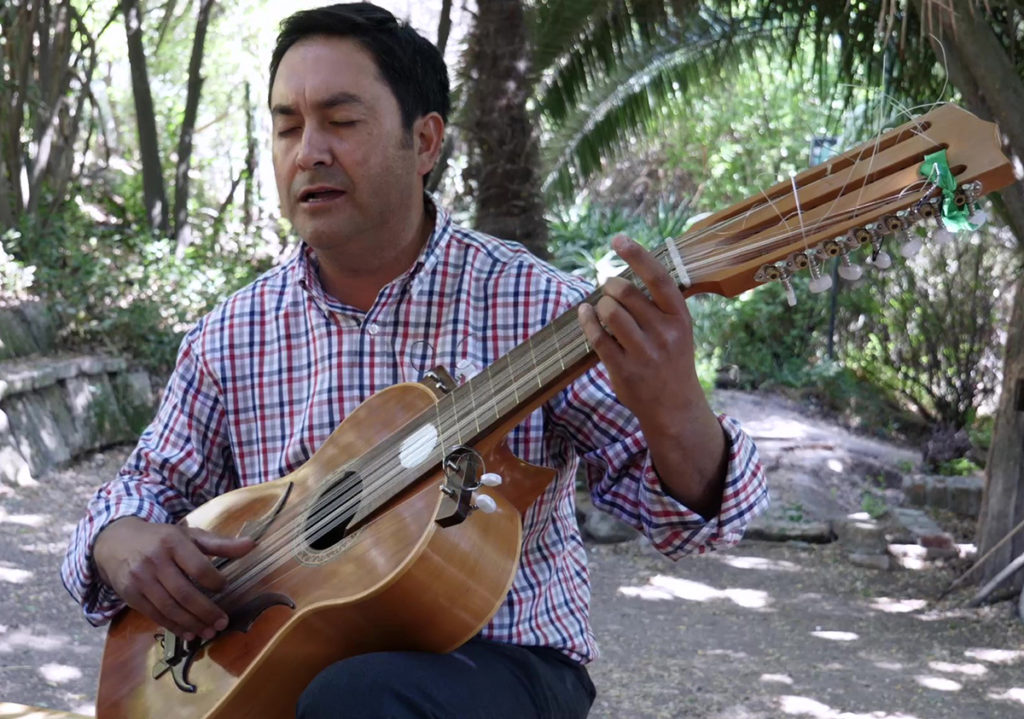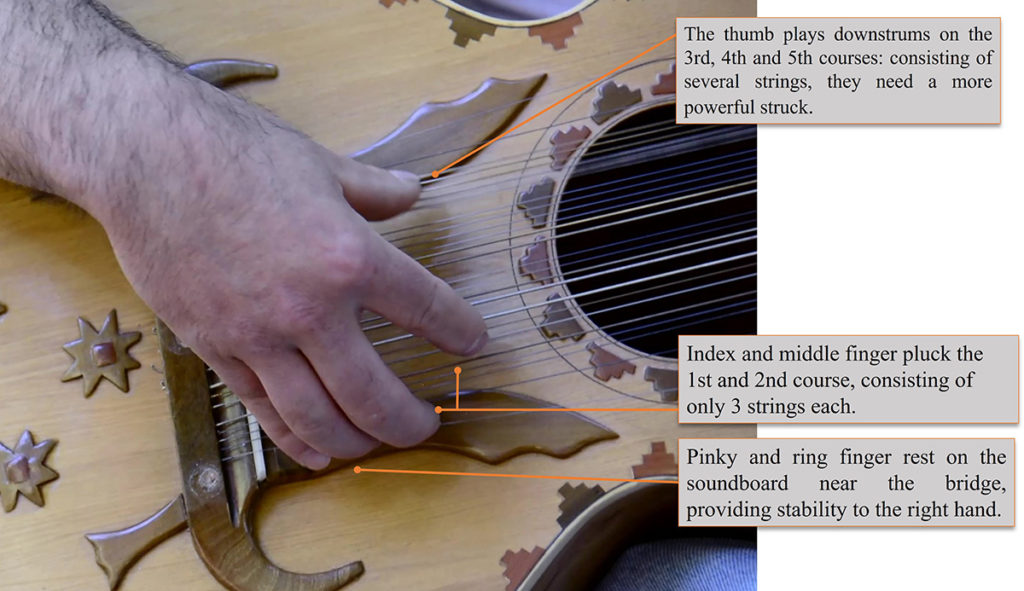Performance techniques

Fig. 2.1. Posture of the singer-guitarronero.

Fig. 2.2. Performance techniques: the position of the right hand.
The toquío
The toquío (from tocar, to touch or play) is the instrumental component associated with the entonación (melody), and is performed on the guitarrón or guitar. The combination of toquío and entonación constitutes the musical form accompanying the verso (the literary form of the composition). While the association between verso and entonación is essentially free, i.e. at the discretion of the individual cantor, each entonación is complemented by a specific corresponding toquío.
Toquíos of the guitarrón
The guitarrón is not easy to tune and play because of the large number of strings, arranged in a proportionally rather cramped space, given that the fingerboard is only slightly wider than that of a standard six-string guitar. The performer sits holding the instrument horizontally, like a normal guitar [Fig. 2.1], or more vertically, resting the bottom of the body on his or her legs. In the first position, the left hand acquires greater agility, while in the second, the right hand is freer. The greatest difficulty for the left hand is having to forcefully press down courses of five or six strings accurately. As a result, simpler fingerings, i.e. with many open strings, are preferred. The right hand, resting on the soundboard near the bridge, plucks the strings by alternating thumb, index and middle finger [Fig. 2.2.] without using the technique of rasgueo – i.e. simultaneous hammering or strumming several strings with the thumb or the other fingers of the right hand, either from the top downwards or vice-versa.
The toquío of the guitarrón consists of a continuous melodic-harmonic sequence, which includes parts with melodic punteo (pizzicato) of single or double notes, and other figures, such as the trinado (trill), i.e. a rhythmically faster sequence on the notes of the chord. These figures are combined in recurring patterns that characterise clausulae at the end of phrases and cadences. To emphasise certain passages, the performer may occasionally also strike the side strings, the diablitos, which complement and emphasise the harmony of the tonic and dominant chords in the high register. Thanks to the high frequency of plucked notes on the open string, with their prolonged resonance intensified by unisons and octaves of each course, the toquío of the guitarrón produces a continuous, flowing legato overall, called the campanilleo (bell-ringing effect), a quality appreciated by performers. The choice of playing technique – such as the simple chordal positions and the continuous alternation of thumb, forefinger and middle finger in the pizzicato – reflect the need not to tire out the instrumentalist, who traditionally had to accompany numerous cantores continuously, even for several hours.
Toquíos of the guitar
In canto a lo poeta the guitar is mainly used with traspuesta tuning (see Instruments). The toquíos of the guitar may also employ punteo and trinado techniques, probably due to the influence of the greatly respected model of the guitarrón and canto a lo poeta: in the video on the guitarra traspuesta, the cantor Roberto Carreño also defines the punteada technique as “a lo poeta”. Most guitar toquíos, however, are based on the techniques of rasgueo, i.e. the rhythmic striking of chords with the fingers of the right hand. The highly varied ways of striking the strings also include the characteristic golpe apagado, in which the hand stops the strings at the same time as it strikes them. The use of open tunings (i.e. producing a concordant harmony on the open strings) allows the right hand’s rasgueo to be used to produce a melody in the high register on the first strings, while the open strings in the middle and low register provide continuous harmonic support in the form of a drone.
The video illustrating the techniques shows examples of how punteo and trinado are played on the guitarrón, and rasgueo on the guitarra traspuesta.
Singing
The vocal style of canto a lo poeta is characterised by a tense, powerful emission, in a register that, given the peculiarities of each singer, generally tends towards the high-pitched, or at any rate the highest range of the singer’s register. The expressiveness of the singing is due to its simplicity, tension and clarity, even in the diction of the text, the pivot of the poet’s performance. There are no affective colourings, such as vibrato or embellishments. One procedure that contributes to enhancing the expressiveness and aesthetic individuality of the singing is what Santos Rubio, a cantor from Pirque, calls “cantar arrogante“: a style in which the voice tends to stretch the phrasing, to avoid coinciding with the rhythmic and regular accentuation of the instrument’s toquío. The verso for Adam and Eve performed by Roberto Carreño provides an example of this deliberate independence between the metre of the instrument and the freer, more dilated metre of the song.
